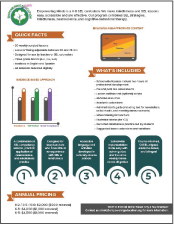How to Make Schoolwide Social-Emotional Learning Work
What would your district or school look like with social and emotional learning (SEL) in every classroom? What if SEL were part of every week or every day? This may sound like a dream to some. Yet, more and more schools are introducing schoolwide SEL.
Let’s first dig into the benefits of schoolwide SEL, and then we can talk about some tips for implementation.
Benefits of Schoolwide SEL
Research shows that when students have opportunities for SEL, they have greater academic success, fewer behavior problems, and higher levels of positive social behaviors (Durlak, et al., 2011). Research out of Harvard, however, has shown that SEL needs to be schoolwide to have an impact.
If SEL is taught in just a few classrooms, or just done by one specials teacher, the messages are not reinforced sufficiently. Additionally, teachers end up reinforcing contradictory messages: “You can’t go off by yourself to calm down during school!” vs. “Would you like to sit in the peace corner to cool off?”
Solve this contradiction by implementing social-emotional learning schoolwide. Here is a shortlist of the benefits:
Schoolwide approaches focus on preventing problems before they occur.
Using an SEL curriculum schoolwide roots a school in relationships and communication. While moments of conflict are great opportunities to help students learn important SEL skills, teaching those skills before the conflicts occur can prevent them.
Social and Emotional Learning Takes Time...But Saves Time!
There are so many demands on a teacher’s time! It's easy to deprioritize social and emotional learning when test scores are talked about so much more. But SEL can actually save time.
Think about what takes up so much of a teacher’s time...behavior management! When students are taught how to self-regulate, resolve conflicts, and make responsible decisions, teachers can find themselves pulled into lesson-distractions less often.
Some teachers may feel that SEL has no connection to academics. Indeed, there are no questions directly about SEL on the state tests! But when students learn how to solve problems, communicate with their peers, identify and overcome their own self-doubts, etc., they are better able to learn.
Schoolwide SEL Looks Different for all Schools.
There are three common approaches to providing SEL instruction:
Every classroom, every teacher: The most powerful approach is to have all classroom teachers use the same curriculum at a consistent time during the week. Our scope and sequence introduce the same concepts each week across all grade bands. The rationale here is that all students are learning the same skills and vocabulary and that teachers will be able to reinforce the ideas during the rest of the day. This approach requires the most training and support, but should yield the most benefits.
- SEL Specials: In addition to art, music, and physical education, SEL can be a special class. This approach has an SEL teacher or two (sometimes but not necessarily a counselor) visiting each class once per week. To make this approach effective, provide the other teachers some focused training on essential SEL ideas and ways they can reinforce those ideas throughout the day. Alternately, have the regular classroom teachers sit in on the classes.
- Mental Health Groups: School social workers and therapists can create small groups teaching SEL skills. This tier 2 or tier 3 approach can be especially helpful for students who need extra learning support. To maximize the impact of this approach, provide focused training to all teachers who interact with the kids in those groups so that the teachers can reinforce the lessons.
So you might be asking yourself, how could I get SEL implemented schoolwide in my district or school? We put together 7 tips for successfully creating a schoolwide approach to SEL:
Tips for Schoolwide SEL Implementation
1. Get buy-in and create a team
“Is this another thing we have to do?!” We’ve all felt and heard this about the latest curriculum. This feeling can come from teachers or administrators not having a sense of involvement in the process.
One way to avoid this is to develop an SEL committee that includes mental health staff as well as classroom teachers and parents. Give them a clear mandate and timeline, and perhaps some donuts. If it’s not possible to have a program chosen by committee, consider having that committee work out an implementation plan.
In our admin blog on bringing SEL to your school, we brought up the importance of getting buy-in from staff and parents. Schoolwide SEL includes the entire school community. Taking the time upfront to get people on board is key for any schoolwide intervention. As an administrator, it is also essential to not do all the work. Have the SEL team review SEL curricula, recommend a selection, and be the champions of SEL at your school.
Don’t forget to add in your own voice as the school leader.
Empowering Education provides school leaders with an admin guide for each week, making it easy to organize bulletin boards, make relevant announcements, or update parents through newsletters or social media.
2. Add SEL into the school schedule
Whatever model of schoolwide implementation your school chooses, make sure there is a consistent time for SEL. Schools that have time set aside are more likely to teach the necessary skills and see results.
Each week, have the same theme across all the grades. While the lessons are differentiated by age, all the kids are working on, for example, coping skills in week 3, making it easy to rally the school. (That’s how our program is organized.)
Having a common time for SEL is also an opportunity for students to serve as mentors to younger students. Some schools have the fifth and sixth graders use the Empowering Education curriculum to teach younger students. This builds community in the school as well as creates mentoring opportunities.
3. Provide training on Social and Emotional Learning
It’s pretty tough to teach a program that you haven’t been trained on! Then, when push comes to shove (i.e., testing schedules), teachers will gravitate towards what they are comfortable doing and know pays off.
Training on any new intervention is critical and SEL is no exception. Teachers may view SEL as "just one more thing they need to do." Remind them that they're always teaching SEL: they're modeling how to handle themselves and others. Making it explicit helps them teach ideas that produce well-adjusted students.. When selecting an SEL program, make sure it offers training on the curriculum as well as trauma-informed tips for teaching SEL. We have seen great success with the Empowering Education trainings in setting up teachers for success.
Be sure to build in time and expectations to get trained up on SEL before starting up the work.
Get PD & Staff Training
Our program includes engaging self-paced training on SEL, Mindfulness, and Trauma-Informed Teaching. Not a member? You’re welcome to join our public workshops at no charge.
4. Connect Families to Social and Emotional Learning
When the lesson is fractions, it’s lovely when parents are reinforcing the lesson at home, but when the lesson is how to talk about feelings, it’s crucial! If parents are not informed about what SEL skills their students are learning, they can’t help teach it.
Inform and involve families! We make that easy for our members by providing them at-home resources that include an explanation of the SEL theme of the week and suggestions on how to continue the lesson at home (and these are in English and Spanish). We also provide administrators with ideas for bulletin boards and wording for social media posts and newsletters.
5. Connect SEL to Academics
SEL lessons get supercharged when the topics are reinforced in other subjects. The academic extensions we provide make this easy, but it’s also easy to weave SEL topics into other classes. For example, explicitly teaching a student about taking someone else’s perspective is a great SEL skill that can show up in an ELA lesson: “What is each character’s perspective on what just happened?” Or reinforce a lesson on apologizing by having students develop skits in which characters in their book apologize to each other.
Can SEL show up in math class? Of course! Many students are anxious about math so there are lots of opportunities to work on lessons around growth mindset, positive thinking, etc. What about science? The lessons in our program on neuroscience such as neuroplasticity and the adolescent brain are prime opportunities to connect SEL to science class.
To support the SEL-core subjects crossovers, educate all teachers about what’s happening in SEL. (That’s why our schoolwide licenses allow for all staff to access the orientation and lessons.) If not every teacher will be doing SEL lessons with their students, train teachers on the “baseline” of SEL ideas that every teacher should know and reinforce.
Get SEL that's easy, afforadable, and effective.
We've worked hard to make our lessons nearly prep-free, including scripts for those teachers who aren’t sure how to talk with students about feelings, relationships, or other Social and Emotional Learning topics.
6. Model Social and Emotional Learning
“Do what I say not what I do” just doesn’t cut it! If teachers aren’t modeling the SEL ideas they’re teaching, the lessons will fall flat. Teachers can struggle with this because, like all of us, they are works in progress! But those moments of falling short of our ideals are great opportunities to model self-compassion, honesty, and emotional literacy. To hear a teacher say “I want to apologize for how I handled the end of class yesterday. I was very anxious about…” is an incredible lesson for students.
We help teachers consider what they’re modeling by pointing out ways to explicitly model the lesson idea. School leaders can reinforce this by making room in staff meetings for a bit of SEL. Have teachers “check-in” to start meetings. Create opportunities for teacher reflection, goal-setting, etc.. Pull in some of the very same activities that we use with students.
7. Reflect and make changes
Test how the program is working at your school and make necessary changes. If you notice a positive change, keep up the consistency. If you notice teachers are not using the program consider making SEL more of a priority at your school. We are always here to support schools looking to expand SEL, so reach out anytime for a consultation.
If your school or district is looking to go schoolwide, contact us and we can help you figure it out!



